 |
THE ACROPOLIS OF ATHENS
The Acropolis hill (acro - edge, polis - city), so called the "Sacred Rock" of Athens, is the most important site of the city. During Perikles' Golden Age, ancient Greek civilization was represented in an ideal way on the hill and some of the architectural masterpieces of the period were erected on its ground. The first habitation remains on the
Acropolis date from the Neolithic period. |
|
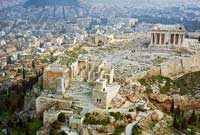 |
|
| Over the centuries, the rocky hill was continuously used either as a cult place or as a residential area or both. The inscriptions on the numerous and precious offerings to the sanctuary of Athena (marble
korai, bronze and clay statuettes and vases) indicate that the cult of the city's patron goddess was established as early as the Archaic period (650-480 B.C.). |
|
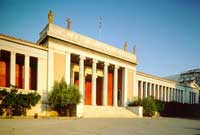 |
|
NATIONAL ARCHAEOLOGICAL MUSEUM OF ATHENS
It is the most important archaeological museum in Greece and one of the richest in the world concerning ancient Greek art. Its collections are representative of all the cultures that flourished in Greece.
The construction of the museum was begun in 1866 and completed in 1889 with the gradual addition of the west wing in 1874, of the |
|
| north in 1881, of the south in 1885 and finally, of the east wing. The building was erected in a large plot donated by Helen
Tositsa, with the financial support of Demetrios and Nicolaos Vernardakis, the Archaeological Society and the Greek state. |
|
THE ACROPOLIS MUSEUM
It is one of the most important museums in the world. It temporarily houses masterpieces of the ancient Greek civilization, dedicated to the most important of the Athenian sanctuaries, the "temenos" of Athena Parthenos. Preparations for the erection of the New
Acropolis Museum have already begun. |
|
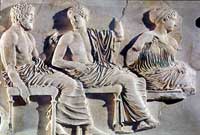 |
|
| Many of the unique works of art that ornamented the Acropolis
have been stolen and transferred abroad. The worst plundering of the monuments took place in the beginning of the 19th century by Lord Elgin. |
|
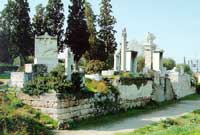 |
|
KERAMEIKOS
Kerameikos was named after the community of the potters (kerameis) who occupied the whole area along the banks of river Eridanos. The walls of
Athens, which were constructed in the 5th century B.C. by Themistocles, divided the area into two sections, the "inner" and "outer" Kerameikos. |
|
| The wall had two gates, Dipylon and the Sacred Gate, placed at the outset of the two most important processional roads of Athens, the Panathenaic Way which led to the
Acropolis, and the Sacred Way which led to Eleusis. Outside the city walls, along the sides of both roads lay the official cemetery of the city, which was continuously used from the 9th century B.C. until the late Roman period.
The finds from the excavations of Kerameikos are exhibited in the Museum of Kerameikos and the National Archeological Museum. |
|
ARCHAEOLOGICAL MUSEUM OF KERAMEIKOS
The museum of Kerameikos was built in 1937 on the plans of H. Johannes, with a donation of Gustav Oberlaender. It was enlarged in the 1960's with the support of the Boehringer brothers. |
|
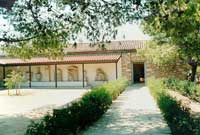 |
|
 |
|
THE EPIGRAPHICAL MUSEUM
The Epigraphical Museum was founded in 1885 and it was established in the ground floor of the building of the National
Archeological Museum, which was constructed between 1866 and 1889, according to architectural plans by L. Lange and E. Ziller. It was renovated and extended in six new rooms, during the years 1953-1960, according |
|
| to plans of the architect P. Karantinos. It comprises a collection of Attic inscriptions and also a collection of inscriptions from other districts of Greece. |
|
MUSEUM OF THE ANCIENT AGORA (STOA OF ATTALOS)
The Agora museum is housed in the Stoa of Attalos, a reconstructed building of around 150 B.C. The characteristic feature of the museum is that the exhibits are all closely connected with the Athenian Democracy, as the Agora was the focus of the city's public life. |
|
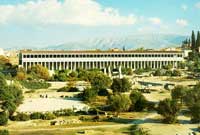 |
|
| The Stoa of Attalos was discovered during the excavations carried out by the Greek Archaeological Society between 1859 and 1902. In 1953-56 it was reconstructed in order to house the finds from the excavations at the Agora. In 1957 the Greek state assumed responsibility for the administration and security of the museum and the archaeological site. |
|
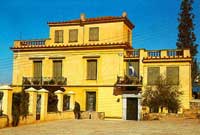 |
|
PAUL AND ALEXANDRA CANELLOPOULOS MUSEUM
The museum was founded in 1976, after the private collection of Paul and Alexandra Canellopoulos was donated to the Greek state. The Neoclassical building on the north slope of the
Acropolis was erected in 1864 and was originally used as the mansion of the Michaleas family. |
|
| In the 1960's-70's the building was purchased by the Greek state and restored to permanently house the collection of antiquities. |
|
BYZANTINE AND CHRISTIAN MUSEUM
The Byzantine Museum was founded in 1914. From 1930 on it has been housed in the "Ilisia" mansion, which belonged to the Duchess of Placentia and was built in 1848 by the architect Stamatis Kleanthes. It was transformed into a museum by the architect Aristotle Zachos. |
|
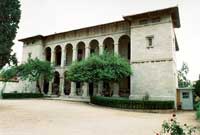 |
|
| Today an addition is being made and a large extension with basement and buildings in part above ground. The architectural design is by Manos
Perrakis. The collections of the Byzantine Museum show the course of Greek art from the 4th to the 19th century. They comprise sculptural works, paintings and small works of all sorts. These works represent the artistic production of the Greek area, and other regions both central and peripheral of the Byzantine empire and subsequently of Hellenism on into post-Byzantine times.
The Museum collections include the following:
Byzantine and post-Byzantine ikons.
Sculpture
Manuscripts
Wall paintings
Mosaics
Small objects (cloth, coins, pottery, metal objects, silver)
Wood carvings
Patterns (anthibola), bronze engravings, lithographs
A collection of old prints (incunabula)
A collection of copies of paintings The Byzantine Museum was founded in 1914. From 1930 on it has been housed in the "Ilisia" mansion, which belonged to the Duchess of Placentia and was built in 1848 by the architect Stamatis
Kleanthes. It was transformed into a museum by the architect Aristotle Zachos. Today an addition is being made and a large extension with basement and buildings in part above ground. The architectural design is by Manos Perrakis. |
|
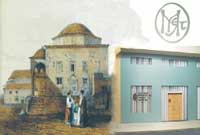 |
|
MUSEUM OF GREEK FOLK ART
The Museum of Greek Folk Art belongs to the state and comes under the Ministry of Culture. It was founded in 1918 under the name "Museum of Greek Handicrafts" and was housed in the Tzami. In 1923 it was renamed the "National Museum of Decorative Arts"; it was given its present name in 1959. |
|
| Anna Apostolaki was the director of the Museum of Greek Folk Art from 1935 to 1953. From 1956 until 1980 it was under the direction of Popi Zora. Until 1973 the Museum was housed in the Tzami in Monastiraki Square. Its main functions were then transferred to the building at Kydathinaion 17 in Plaka. |
|
NATIONAL ART GALLERY AND ALEXANDROS SOUTZOS MUSEUM
The National Art Gallery and Alexandros Soutzos Museum, the most important institution in Greece devoted to the subject of the history of Greek and Western European art, has been in operation, in its present form, since 1976. |
|
 |
|
| The actual founding of the institution dates back to 1900, when the relevant decree was published and the duties of curator were undertaken by George Iakovides (1900-1918). Already, however, in 1834, within the framework of the new social organization - on Western European lines - of the newly-born Greek state, the decree "On Technological Collections" provided for the founding, in
Athens, of a Museum of paintings and engravings. |
|
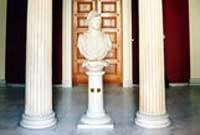 |
|
NATIONAL HISTORICAL MUSEUM
The National Historical Museum belongs to The Historical and Ethnological Society of Greece (HESG), which was founded in 1882 for the purpose of collecting, saving and presenting relics and documentary evidence relating to modern Greek history. It is the oldest museum of its kind and it includes rich collections,
which highlight the most |
|
| representative phases of Neo-Hellenism, from the fall of Constantinople (15th Century) on. The National Historical Museum is also a research center for Modern Greek History. |
|
|
 |
|
|
|